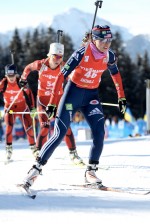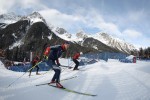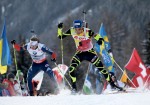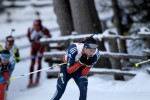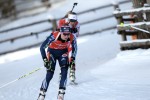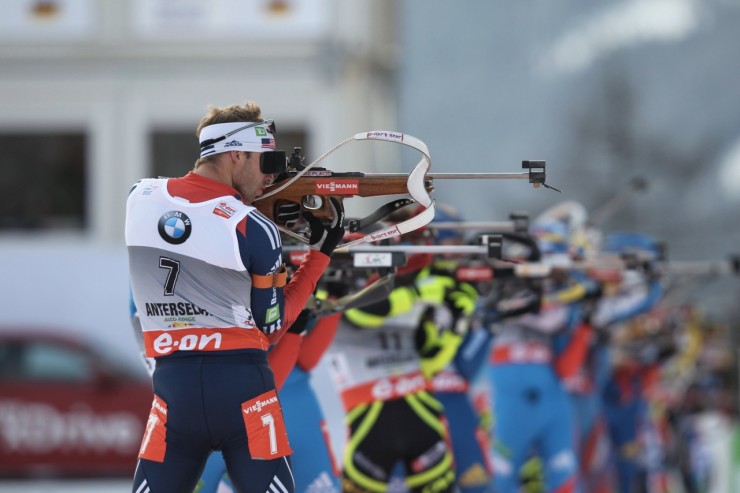
In today’s 10 / 12.5 k pursuit races in Antholz, Italy, Tim Burke and Lowell Bailey led the way for North Americans by finishing 14th and 16th. For Bailey, it was a slight slip in the standings after placing seventh in the sprint.
Burke, however, had the third-fastest ski time of the day and had moved up from starting 45th. The beginning of his race was particularly quick: he skied the fifth-fastest first-loop time and then the fastest second-loop time, while cleaning both prone stages. After prone, he was sitting in 19th place.
“I did not plan on starting so hard today but I just felt really good right from the start,” Burke wrote in an e-mail to FasterSkier. “I also don’t mind pushing a little more into the red zone before prone shooting but I prefer to back off a little more before my standing shooting. All of the sudden on my third loop I really started to go under and I thought I was in big trouble so I backed off quite a bit. Luckily, I seemed to bounce back for the 4th and 5th loops.”
Bailey, too, started strong and went 0-1 in the first two stages. Thanks to his good shooting he could stick with a group that was chasing wire-to-wire leader Anton Shipulin of Russia; Bailey sat in fifth after the first stage and ninth after the second, and skied with Martin Fourcade, Emil Hegle Svendsen, and Evgeniy Garanichev, among others.
“I felt great from the start of the race and it was fun to be up in the top group,” he told FasterSkier. “I was really just focusing on my own race and not really trying to get caught up jockeying for position. That being said, it is always easier to stay with a group and after missing one in the second prone, I lost contact with that lead pack and fell back a bit.”
Meanwhile, Burke gave a picture of what it was like to start far in the back and work his way through the field.
“Most of the time I was moving through the groups today but I would always try to use the draft a little to get a break and then make a move for the next group,” he wrote. “The course here suits my style very well. I can V2 almost the entire course and this is definitely my strongest technique.”
Leif Nordgren also started the pursuit for the U.S., and moved two spots from 40th up to 38th.
For Canada, Jean Philippe Le Guellec had a similar strategy to Burke’s after starting 58th. With four penalties he didn’t have quite the luck of the American, but nonetheless turned in an impressive performance and climbed up to 39th.
“Starting in the back is not as tactical as other areas of the field, the idea is to keep up or pass skiing, and shoot as few penalties as possible: especially in prone,” he told FasterSkier.
Mission accomplished on that front: cleaning the very first stage and skiing the 13th-fastest opening lap immediately moved Le Guellec up to 38th, where he hovered for the rest of the race.
“I had a good view of how the race was taking shape during the whole thing and noticed it was already wide open after the prone,” he said. “I was slipping in and out of the 30’s, so I knew I wouldn’t be knocked down too far despite penalties in standing. Although I would have preferred less!”
While the Antholz courses seem to suit Burke and Bailey particularly well, they are a bit more challenging for Le Guellec.
“The course here and my style of skiing are an explosive mix for my back,” he reported. “It really tightens up and makes skiing and shooting standing quite a challenge… so, in a way, I was happy leaving the range with as little as three penalties in two bouts. I felt it could easily have been worse! I’ll have to get it worked pretty good tonight so it’s in okay shape tomorrow for the relay.”
Teammate Scott Perras was also a big mover, starting last in 60th place but jumping all the way up to 43rd. But Perras struggled out of the gate, missing two shots in the first prone stage. After that he took a penalty per stage and gradually climbed his way out of the back of the field.
Both the American and Canadian men are looking not only to the relay on Sunday, but also towards World Championships. While Le Guellec hasn’t repeated his sprint success from the first week of racing in Ostersund, Sweden, where he won his first career World Cup, he believes he can take another victory and that things are shaping up well for the championships, which start in less than three weeks.
“This is the most solid I’v been in a while, which is refreshing,” he said. “The results don’t show it so positively, but I’ve been in the mix for top 10’s in pretty much every sprint after Christmas. Shooting has obviously been the issue, not that it was bad, but there is no room for mistakes. Once you’ve committed one, you’re rapidly getting bumped down the list. So I’m confident heading into training pre-World Champs.”
The U.S. plan is to take a short break after Sunday’s relay – it has been an intense three-week block of racing – and then focus for the Championships, which will be held in Nove Mesto, Czech Republic.
“All athletes have individual free time and the World Championships camp starts then January 28th here in Antholz,” U.S. High Performance Director Bernd Eisenbichler explained. “Most athletes stay for the full three weeks now in altitude right next to the venue, and then we drive February 3rd over to Nove Mesto. We will not do crazy new things now in preparing for these World Championships , but work on individual specific needs and execute the work.”
Finally, some notes on the women’s race, where Annelies Cook led North Americans in 37th. Unlike the men’s race, where most of the field shot well (with a few notable exceptions like German star Arnd Peiffer, who missed a whopping nine shots; in fact with the exception of Florian Graf’s four penalties, all of the German men had to ski at least six penalty loops), the women struggled in standing.
The wind flags were calmly fluttering, and yet only four women were able to knock down all ten standing targets. Sara Studebaker, who finished 39th, confirmed that there was “no crazy wind” in the Antholz stadium.
“This range is a tough one – you can definitely come in too hot, especially for standing which can mean a lot of penalties,” she explained in an e-mail. “The altitude tricks people a little, since you can’t go quite as hard as normal… you really feel it skiing and have to make some adjustments in shooting. For example, I’ve been using a two breath cadence here, when normally I use one.”
As for her own performance, Studebaker was happy with the end of it, when she cleaned the last standing stage and took off onto the trails.
“I have to give Hannah [Dreissigacker] props for her cheering, because until I got to where she was on my last loop, I had no idea where I was [in the field],” Studebaker said. “She told me I was in 42 and I could see the two girls ahead of me, so I was able to turn it on with enough time to catch them and get into the points.”
Susan Dunklee placed 44th for the U.S., and Zina Kocher and Audrey Vaillancourt 45th and 49th for Canada.
Chelsea Little
Chelsea Little is FasterSkier's Editor-At-Large. A former racer at Ford Sayre, Dartmouth College and the Craftsbury Green Racing Project, she is a PhD candidate in aquatic ecology in the @Altermatt_lab at Eawag, the Swiss Federal Institute of Aquatic Science and Technology in Zurich, Switzerland. You can follow her on twitter @ChelskiLittle.

